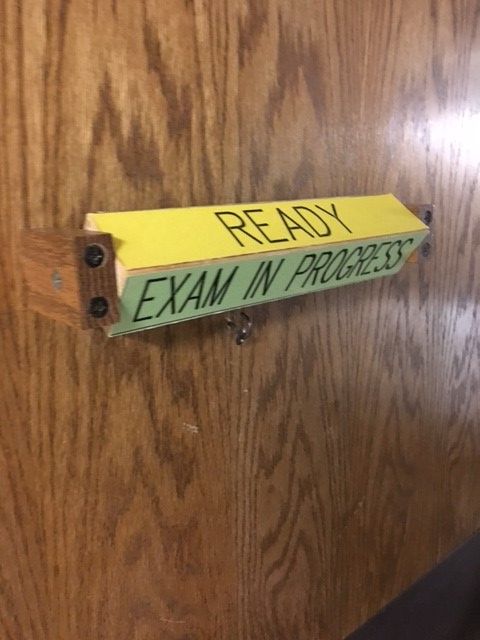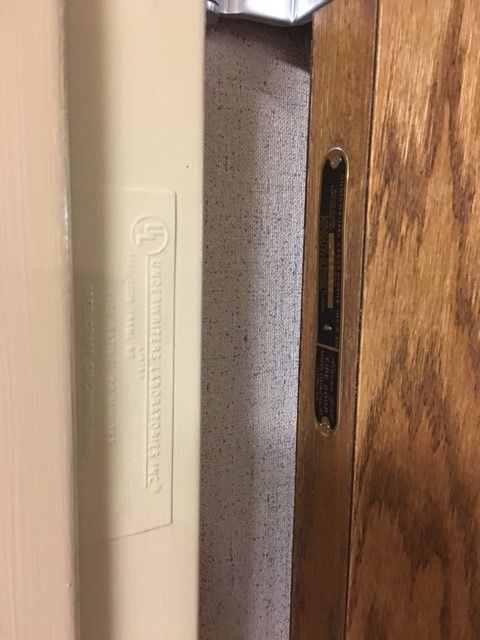If you read my recent article on code requirements pertaining to signage, you’ll be able to identify the problem with this creative Fixed-it Friday signage on a fire door assembly. Thank you to John Lozano of Allegion for the photos!
You need to login or register to bookmark/favorite this content.








Signage is not to exceed 5% and “Must use adhesive” not screws! 2nd infraction is painted UL label on jamb.
I think they’re ok with the area of the signs (although I’m not sure how to calculate a 3D sign like this), but the screws are a problem. This type of signage probably doesn’t meet the intent of NFPA 80, but the standard doesn’t specifically call out flat signs so it’s open to interpretation. The painted label is probably ok if it is still readable. At one time, UL issued a bulletin ok-ing painted labels as long as they were still legible.
– Lori
“NFPA 80 2013:
4.1.4 Signage Informational signs shall be permitted to be installed on the surfaces of fire doors in accordance with 4.1.4.1 through 4.1.4.4 or in accordance with the manufacturer’s published listing.
4.1.4.1 The total area of all attached signs shall not exceed 5 percent of the area of the face of the fire door to which they are attached.
4.1.4.2 Means of attachment.
4.1.4.2.1 Signs shall be attached to fire doors by use of an adhesive.
4.1.4.2.2 Mechanical attachments such as screws or nails shall not be permitted.
4.1.4.3 Signs shall not be installed in glazing material in fire doors.
4.1.4.4 Signs shall not be installed on the surface of fire doors so as to impair or otherwise interfere with the proper operation of the fire door.”
Thanks Daniel. The reason I don’t usually put the code section into the article is because I’d have to ask NFPA’s permission each time. So I write about what the requirements mean, and if someone wants to see the actual code language it is available on NFPA.org.
– Lori
I believe that you can’t have anything on the door that’s not fire rated and also only exit signage can be used.
Hi Anthony –
For signage, the rules are that it has to be attached with adhesive, and can’t cover more than 5% of the area of the door face. The signs themselves don’t have a listing, although almost everything else attached to a fire door needs a listing/label. There’s more info about signage in this article: http://idighardware.com/2017/01/decoded-requirements-for-door-related-signage-february-2017/.
– Lori
The sign should have had an adhesive back and screws are not allowed. What is the manufacture date of that wood door? Mineral core wood doors manufactured 1980 or older have a very high chance the core is asbestos based
Hi Roger –
I’m not sure how old the fire door is, but generally the old cores are ok unless you’re drilling into the door – no?
– Lori
If a sign might need to be changed periodically, would it be acceptable to use some form of adhesive-backed
standoff assemblies that contained screw threads, and then affix the sign using screws that mate only with those threads
and don’t touch the door? Would there be some recommended procedure for indicating that something that might appear to be screwed into the door, actually wasn’t (because e.g. each side of the frame above contained a concealed assembly with two stand-offs mounted to an adhesive-backed plate?)?
NFPA 80 doesn’t get that far into the nitty-gritty, so it would be up to the AHJ.
– Lori
at least they can actually still read the painted label
For arguments sake; let’s say the “standoffs” (of this 3-D sign) were attached with an adhesive (and not screws). Could we then, just measure the two “standoffs” (width x ht.) and combine these two surface areas to determine total signage area [not the entire sign]?
It seems, only the areas of the two contact points (“standoffs”) are the actual attached-sign. The remainder (majority of the sign) is suspended away from the door and should fall away, once the ambient temperature rises and the adhesive releases its hold.
I can’t answer that one. I understand your argument, but what if someone made a sign out of stainless steel that was 2 feet wide and 6 feet tall? Then they attached it onto the face of the door using 6 stand-offs…4 at the corners plus 2 more centered in the height and attached with adhesive. The area attached to the door would be tiny, but the giant piece of stainless could affect the performance of the door before it falls off, which is what the signage limitations in NFPA 80 are trying to avoid.
– Lori
When installing safety hardware, such as this fire door signage, it’s important that the hardware is compliant with industry protocols. Check with your local fire department and any governing bodies that relate to your industry to make sure that you adhere to the safety standards.